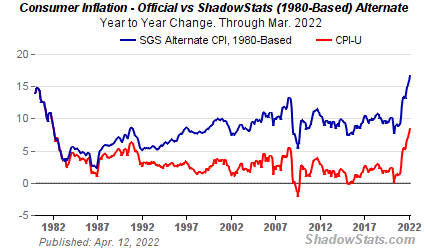Inflation isn’t something that just happened. It’s been happening. It’s been rising for decades and government has been misinforming the public. Since the Ronald Reagan Administration the U.S. Government changed the way consumer inflation is calculated. In fact, inflation has been above 5% consistently and probably close to 7% on average until 2020. In 2020 we surged past the crippling inflation of the late 1970s and that’s why it feels like we got hit by a ton of bricks.
The changing costs of maintaining a constant standard of living were measured by pricing out a fixed-basket of goods and services—same components, same weighting—period after period. Whatever the percentage change was in the cost of that basket of goods, that is how much income would have to rise in order for someone to maintain a fixed- or constant-standard of living over the given period. At least it was a reasonably consistent approximation of same.
Tracking changes in the cost of a fixed-basket of goods was the approach to estimating inflation, going back to at least the 1700s,[i] and prior to 1945, the fixed-basket CPI tracked by the U.S. government actually was known as the Cost of Living Index.[ii]
In the first half of the 20th century, though, the concept of a “constant level of satisfaction” evolved in academia, as a “true cost of living” concept. The general argument was that changing relative costs of goods would result in consumer substitution of less-expensive goods for more-expensive goods. Allowing for a substitution of goods within the formerly fixed-basket, the maximization of the “utility” of money held by consumers would allow attainment of “constant level of satisfaction” for the consumer. This type of inflation-measure is more appropriate for the GDP concept—where it is used today—measuring shifting weightings with actual consumption, rather than with the fixed weightings needed to assess the costs of maintaining a constant standard of living.
Comment on Inflation Measurement – ShadowStats
Take a look at the chart below. The red line is what the U.S. Government is telling the public. The blue line is actual inflation the way it was calculated prior to 1980. It’s clear the gap between what we’re told and what is happening is getting larger.
The reason we’re feeling the pinch so quickly this time is the perfect storm of trillions of dollars created out of thin air since the bank bailouts in 2009/2010, idiotic COVID-19 policies that shut down world economies in 2020, and now the Ukraine/Russia conflict.
In 2020, to counteract the pandemic’s impact, Donald Trump pushed through Congress two enormous stimulus packages mostly funded by increases in America’s already obscene public debt. The next year, Joe Biden pursued a similar path, claiming that stimulus packages were necessary to get the economy moving again.
Overhanging all this was a Federal Reserve that, from 2009 to 2014, deployed what’s called quantitative easing—the purchase of preset amounts of government bonds and other financial assets to inject money into the economy—to boost economic activity. When the government, in March 2020, shut down the economy, Jerome Powell’s Fed returned to quantitative easing programs on a scale that dwarfed previous efforts.
The result of all this money being pumped into the economy is higher prices and a decline in our money’s purchasing power. This is reflected in everything from the price of eggs to women’s dresses to electricity to the rent you pay every month. As if to add insult to injury, “scarcity inflation,” which is due, in part, to disruptions to the supply chain, have compounded our inflationary woes. Just one example: recently, on eBay, people have started listing baby formula and asking would-be buyers to make a bid—triggering bidding wars among frantic mothers who have had trouble finding formula in grocery stores. The responsibility for most, if not all, of this lies squarely with policy makers in Washington, D.C.
That Doesn’t Feel Like $150 Worth of Groceries – Common Sense
We were the proverbial frog in the pot not feeling the heat until Trump and Biden put the burner on high.

